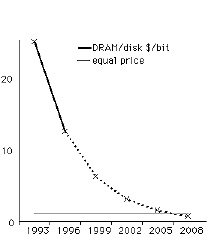
consistent changes over time
Trends are driven by two issues: what is possible technically, and what the market demands.
The major trend in DRAM, the main memory of computers today, is driven by the demand for more and more memory. Density -- the amount that can be packed onto one chip -- improves by a factor of 4 every 3 years. On the other hand, DRAM speed improves by only a factor of 7% per year.
Since SRAM is mainly built out of transistors (using essentially the same technology as the processor chip), SRAM density improves at the same rate as component density on processors, i.e., by about 50% per year, a slightly slower rate than DRAM density. On the other hand, SRAM speed improves by about 40% per year.
Is memory keeping up with processing speeds? No. Since the mid-1980s, when microprocessor technology became more sophisticated, processor speed has been improving by 50 to 100% per year. Caches, which bridge the speed gap between the processor and main memory are becoming increasingly important.

Meanwhile, what is happening to disks?
Disks have traditionally improved in density by a factor of 2 every 3 years -- so will DRAM eventually be cheaper than disk? Does this promising trend picture actually predict the future: DRAM cheaper than disk around 2005?

| Memories are Made of This 17:30 Thurs 12 September 1996 SHB5, Senate House, University of the Witwatersrand, Johannesburg, South Africa |
